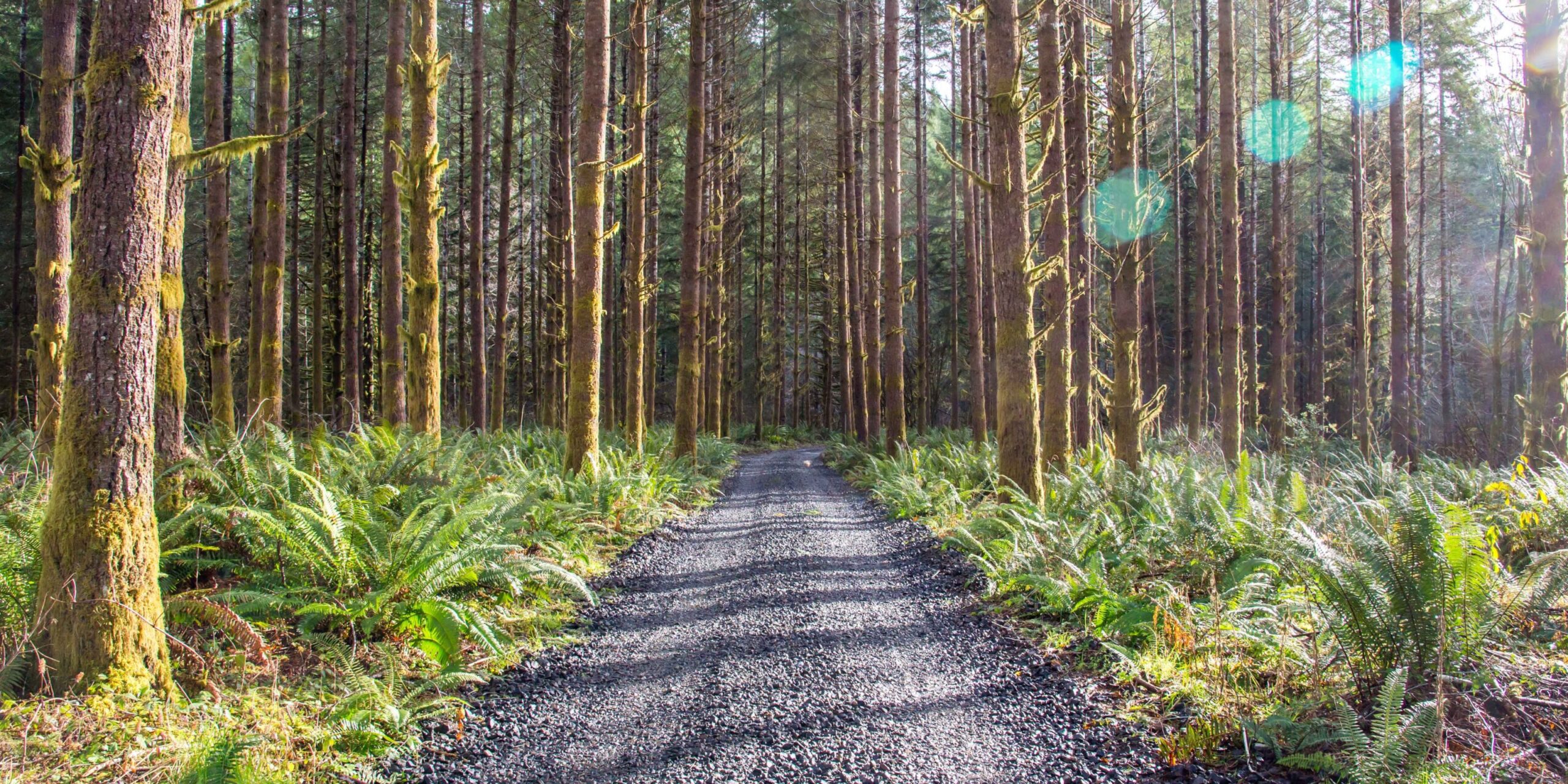
Work. Play. Renew.
Oregon Forest Quiz
Want to test your Oregon forest knowledge and have a little fun in the process? Take our quiz! We’ll see if you’re standing tall at the end or yelling “timber!” because you’re in need of some help.
Get stuck along the way? Just browse the Oregon Forests Forever site to find all the answers and grow your knowledge of fun Oregon forest facts!
A. Zero
B. Less than half
C. Exactly half
D. More than half
D. More than half
Oregon’s 30 million acres of forest capture and store more than half of Oregon’s annual human-caused carbon emissions, making our atmosphere cleaner. When trees are cut down and used for lumber, that carbon remains safely stored away. Newer trees can then be planted in their place, ensuring the cycle of sustainable forestry practices continues.
[/et_pb_accordion_item][et_pb_accordion_item title=” 2. Who owns the majority of Oregon forestland?” open_toggle_text_color=”#244f00″ _builder_version=”4.22.0″ _module_preset=”default” body_font_size=”13px” global_colors_info=”{}” toggle_text_color=”#337700″ open=”off”]A. Federal government agencies
B. State government agencies
C. Native American tribes
D. Private landowners
A. Federal government agencies
The US Forest Service, Bureau of Land Management, and National Park Service manage a combined 61 percent of Oregon’s forestland. Private owners manage 34 percent, followed by state and county governments and Native American tribes.
[/et_pb_accordion_item][et_pb_accordion_item title=”3. Where does the majority of Oregon’s timber harvest happen?” open_toggle_text_color=”#458c07″ _builder_version=”4.22.0″ _module_preset=”default” body_font_size=”13px” global_colors_info=”{}” toggle_text_color=”#337700″ open=”off”]A. Federal land
B. State land
C. Private land
D. Native land
C. Private land
While the federal government manages the majority of Oregon forestland, about three-quarters of the state’s timber harvest comes from private land.
[/et_pb_accordion_item][et_pb_accordion_item title=” 4. When it comes to lumber production within the United States, where does Oregon rank among other states?” open_toggle_text_color=”#458c07″ _builder_version=”4.22.0″ _module_preset=”default” body_font_size=”13px” global_colors_info=”{}” toggle_text_color=”#337700″ open=”off”]A. First
B. Third
C. Fifth
D. Eighth
A. First
Oregon ranks number one in softwood lumber production within the United States, making up 17 percent of the total softwood lumber production in the country as of 2021.
[/et_pb_accordion_item][et_pb_accordion_item title=” 5. What is the state tree of Oregon?” open_toggle_text_color=”#458c07″ _builder_version=”4.22.0″ _module_preset=”default” body_font_size=”13px” global_colors_info=”{}” toggle_text_color=”#337700″ open=”off”]A. Western hemlock
B. Oregon White Oak
C. Douglas-fir
D. Bigleaf maple
C. Douglas-fir
The Douglas-fir is Oregon’s state tree. It’s an evergreen tree that can grow up to 330 feet tall.
[/et_pb_accordion_item][et_pb_accordion_item title=”6. When is Arbor Day observed each year?” open_toggle_text_color=”#458c07″ _builder_version=”4.22.0″ _module_preset=”default” body_font_size=”13px” global_colors_info=”{}” toggle_text_color=”#337700″ open=”off”]A. First Monday in April
B. First Friday in April
C. Last Monday in April
D. Last Friday in April
D. Last Friday in April
Arbor Day is observed each year on the last Friday of April. It’s a day dedicated to celebrating trees and the important role they play in our lives.
[/et_pb_accordion_item][et_pb_accordion_item title=”7. Which of the following are benefits of nature and spending time among trees?” open_toggle_text_color=”#458c07″ _builder_version=”4.22.0″ _module_preset=”default” body_font_size=”13px” global_colors_info=”{}” toggle_text_color=”#337700″ open=”off”]A. Increased endorphin levels
B. Improved concentration
C. Reduced anxiety and decreased stress
D. All of the above
D. All of the above
Studies have shown that spending time in nature can have both cognitive and emotional benefits. Even spending as little as two hours a week in nature is associated with good health. If you want to improve your physical and mental well-being, go for a nature walk or take advantage of one of Oregon’s many recreational opportunities in the great outdoors.
[/et_pb_accordion_item][et_pb_accordion_item title=”8. Roughly how many Oregonians work in the timber industry?” open_toggle_text_color=”#458c07″ _builder_version=”4.22.0″ _module_preset=”default” body_font_size=”13px” global_colors_info=”{}” toggle_text_color=”#337700″ open=”off”]A. 40,000
B. 60,000
C. 80,000
D. 100,000
B. 60,000
From foresters to loggers to mill workers, there are many jobs to be found in Oregon’s timber industry, which employs more than 60,000 people. Not only do those in the forestry industry report high job satisfaction, but the industry also has higher than average wages. Timber jobs often pay 3 percent more than the average Oregon wage, and in some areas, pay nearly twice as much as the state average.
[/et_pb_accordion_item][et_pb_accordion_item title=”9. How many trees do Oregon’s foresters plant by hand each year?” open_toggle_text_color=”#458c07″ _builder_version=”4.22.0″ _module_preset=”default” body_font_size=”13px” global_colors_info=”{}” toggle_text_color=”#337700″ open=”off”]A. 10 million
B. 20 million
C. 30 million
D. 40 million
D. 40 million
Oregon’s foresters plant 40 million trees each year—at least three for each one that is harvested. It will take a full generation for many of these trees to mature and grow.
[/et_pb_accordion_item][et_pb_accordion_item title=”10. What type of land produces the highest quality water in Oregon?” open_toggle_text_color=”#458c07″ _builder_version=”4.22.0″ _module_preset=”default” body_font_size=”13px” global_colors_info=”{}” toggle_text_color=”#337700″ open=”off”]A. Agriculture land
B. Forestland
C. Mixed-use land
D. Rangeland
B. Forestland
Oregon Department of Environmental Quality data shows that Oregon’s forests produce the highest quality water in the state, including working forests that have been harvested and replanted. Sustainable forest practices foster a healthy, clean environment for our future generations, wildlife, and aquatic species alike.
[/et_pb_accordion_item][/et_pb_accordion][et_pb_text _builder_version=”4.22.0″ _module_preset=”default” global_colors_info=”{}”]From fun trivia to serious facts about Oregon’s forests and all they have to offer, Oregonians love to talk about trees. Explore the Oregon Forests Forever website and find out more about forest management, wildfire prevention, forest recreation and more. Explore current news and updates about forestry jobs, forest resources and, what else?—Oregon’s trees! You can discover the latest research on the Studies and Resources page. You can even sign up to receive the most up-to-date information about Oregon forests and how you can help them thrive. What will you do for the trees?